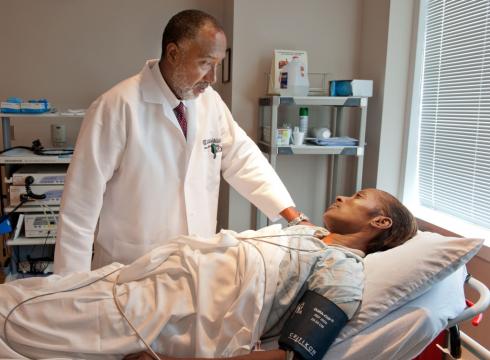Abstract: Academic literature has consistently illustrated that Medicaid patients—adults and children—have inferior access to health care, and notably poorer health outcomes, than privately insured patients. Due to the program’s low reimbursement rates, more and more doctors are refusing to even accept Medicaid. As a result, it is becoming increasingly difficult for Medicaid patients to find access to primary and specialty care physicians. When Medicaid patients are admitted to hospitals, they are often admitted with more serious conditions than those with private insurance. By further expanding this broken program, Obamacare will only exacerbate the situation, continuing to harm many low-income Americans who have no option other than Medicaid. Policymakers should reform Medicaid to allow Medicaid patients access to private insurance in a consumer-driven market.
Established as a fundamental component of President Lyndon Johnson’s Great Society, Medicaid is a jointly funded federal and state program that pays for health care for low-income individuals. The academic literature has consistently illustrated that Medicaid patients have poorer access to care, and poorer health outcomes, than privately insured patients. By further expanding this broken program, the Patient Protection and Affordable Care Act—Obamacare—only exacerbates the situation. Policymakers should reform Medicaid to provide consumers with greater access to private insurance in a consumer-driven market.
Medicaid typically pays physicians 56 percent of the amount that private insurers pay.[1] Given these low reimbursement rates, more and more doctors are refusing to accept Medicaid.[2] As a result, it is becoming increasingly difficult for Medicaid patients to find primary care doctors and specialists. When Medicaid patients are admitted to hospitals, they are often admitted with more serious conditions, and in some cases, with a higher level of co-morbidity, than privately insured patients. The peer-reviewed academic literature clearly illustrates Medicaid’s problems for children as well as for adults.
Children Suffer Under Medicaid
Medicaid undermines care for millions of children. Consider, for example, children with asthma, one of the most common chronic diseases affecting children in the United States. A 2001 study published in the Journal of Health Care for the Poor and Underserved compares hospital care for children with asthma who are covered by Medicaid to children with asthma who are covered by private insurance in California, Georgia, and Michigan.[3] The authors found slightly longer length of stay and significantly poorer outpatient care for the children on Medicaid. In terms of outpatient care, the authors specifically found that pediatric Medicaid patients were more likely than privately insured patients to be discharged on subpar medication routines. The authors also found that Medicaid patients generally lacked a consistent source of outpatient care, unlike privately insured patients. These issues with outpatient care suggest that these children are more likely to be re-admitted for hospitalization at a subsequent time in the future.
Adequate access to care is also a serious problem for children on Medicaid. A 2004 study published in Pediatrics examined children’s access to specialty surgeons in Southern California.[4] The researchers surveyed specialty surgeons throughout southern California and found that the surgeons are generally less inclined to accept patients enrolled in Medi-Cal (California’s version of the Medicaid program). The surgeons cited difficult paperwork, administrative burdens, and poor reimbursement rates as reasons for not wanting to take on these patients. The authors consequently caution policymakers about expanding this program, noting that coverage through Medi-Cal does not necessarily signify meaningful access to health care. The authors also suggest that expanding Medi-Cal may in fact exacerbate the existing problems of limited access to care.
Another study published in 2005 in Urology found similar problems with boys’ access to urologic care.[5] The authors surveyed a simple random sample of urologic offices located throughout California in order to determine the offices’ attitudes toward Medi-Cal recipients. Of the offices they found that were willing to see pediatric patients, the authors found that 96 percent of these offices would accept privately insured patients. They also found that only 41 percent of these offices would accept Medi-Cal patients. Three-quarters of the offices that refused to accept Medi-Cal patients were unable to even recommend offices that would.
Furthermore, a recent study published in the New England Journal of Medicine examined pediatric access to specialty clinics in Cook County, Illinois. Sending out research assistants posing as mothers and making phone calls to a random sample of specialty clinics, the study found a significant disparity between access to specialty care for privately insured children and children on Medicaid as well as the publicly funded Children’s Health Insurance Program (CHIP). Specifically, the researchers noted more denials of appointments as well as longer waiting times for Medicaid and CHIP patients than for privately insured patients.
These studies suggest that children on Medicaid lack access to the kind of care that privately insured patients enjoy. As long as the program in its current form remains in place, these problems will persist.
Adults Suffer Under Medicaid
Children are not the only ones Medicaid is failing. A number of academic studies have also pointed out the disparities in health outcomes between adult Medicaid recipients and those who are privately insured.
A 1993 study published in the New England Journal of Medicine found that breast cancer patients in New Jersey were often diagnosed with more advanced stages of the disease and had higher risks of death if they received their insurance coverage through Medicaid instead of private insurance.[6] These findings have been corroborated by a number of subsequent studies looking at a variety of serious illnesses:
- A 2000 study published in Cancer examined health outcomes of breast cancer patients in Florida. The study found that, as a result of later diagnoses, Medicaid patients have higher mortality rates than patients who are covered by commercial fee-for-service insurance.[7]
- A 2000 study published in the American Journal of Public Health that examines colorectal cancer treatments and outcomes found that Medicaid patients not only had higher mortality rates, but were also less likely to receive cancer-directed surgery, than patients using commercial fee-for-service insurance.[8]
- A 2001 study published in Cancer compared health outcomes for a variety of cancers for patients in Michigan. The study found that Medicaid patients had significantly higher rates of occurrence as well as higher risks of death for breast, cervix, colon, and lung cancers compared to non-Medicaid patients. The study also found that Medicaid patients had a higher risk of being diagnosed with these cancers at later stages.[9]
- A 2003 study published in the Archives of Internal Medicine that compares health outcomes for colorectal, lung, prostate, and breast cancer in Kentucky for a variety of insurance classifications also found similar results. For all four illnesses, the authors found that survival rates are markedly higher for privately insured patients than for Medicaid patients.[10 ]
Most recently, a 2010 study in the Journal of Hospital Medicine found similar results for non-cancer-related illness. In this study, the authors examine the relationship between insurance status and health outcomes for myocardial infarction, stroke, and pneumonia patients.[11] The authors statistically analyzed a nationally representative hospital database and noticed, even after adjusting for factors such as age, gender, income, other illnesses, and severity, higher in-hospital mortality rates for Medicaid patients than for privately insured patients. Additionally, even after adjusting for these factors, the study found that Medicaid patients hospitalized for strokes and pneumonia also ran up higher costs than the privately insured, as well as the uninsured.
Medicaid: Hinders Access to Care, Fails to Meet Patients’ Needs
A number of academic studies over the years have illustrated that Medicaid patients have consistently had poor access to care and that Medicaid fails to meet important needs:
- A 1992 study in the Journal of the American Medical Association examined hospitalizations in Massachusetts and Maryland.[12] The study found that Medicaid and uninsured patients were statistically more likely than privately insured patients to be hospitalized for avoidable conditions such as pneumonia and diabetes.
- A 2007 study in Health Affairs examined access to specialty services for patients who receive primary care from community health centers.[13] The study found that Medicaid recipients have significantly more difficulty accessing specialty care than privately insured patients.
- A 2012 study in Health Affairs examined physicians’ willingness to accept new patients. Using survey data from a nationally representative sample, the study found that nearly one-third of physicians nationwide will not accept new Medicaid patients. Doctors in smaller practices, as well as doctors in metropolitan areas, are among the least inclined to accept new Medicaid patients.[14] The authors’ results suggest that this reluctance may largely be a consequence of Medicaid’s poor payment rates to doctors.
Given these findings in the peer-reviewed literature, it is not surprising that Medicaid patients often arrive at emergency rooms in poor, and in many cases, untreatable condition. In fact, research has shown that Medicaid and CHIP patients end up in emergency rooms even more frequently than uninsured patients.[15]
Solutions
As the academic research has consistently suggested, Medicaid’s so-called safety net cripples the very people it is designed to help. To fix the broken safety net, Congress should consider the following.[16]
- Repeal Obamacare and its Medicaid expansion. One of Obamacare’s greatest pretenses is that it improves access to health care. The new law attempts to achieve this goal by dumping millions more patients into the broken Medicaid system. Recent Heritage Foundation research has statistically illustrated the debilitating effect that Medicaid expansion will impose on state governments.[17 ]
Some proponents will likely argue that Obamacare addresses access issues by providing additional federal funding to increase physician reimbursement to Medicare levels. However, this additional federal reimbursement is only temporary and solely applies to primary care physicians. As a result, it is only a matter of time until state budgets become more burdened and a lack of access to meaningful health care becomes even more of a problem nationwide.[18]
- Maximize access to private health insurance for Medicaid beneficiaries. The best approach to improving access and outcomes would be to integrate the success of private health insurance into the Medicaid system. Some states, such as Florida, have pursued reforms in the past decade by giving Medicaid patients a choice of private managed care plans. A five-county pilot version of the program flattened Medicaid costs and had been saving the state slightly under $120 million annually. Additionally, the program overall noted greater access to care, higher degrees of patient satisfaction, and a marked improvement in health outcomes.[19 ]
The Heritage Foundation’s Saving the American Dream proposal goes further. It recommends transitioning non-disabled Medicaid beneficiaries out of the failing Medicaid program and into private health insurance and integrating private, patient-centered models into Medicaid to better serve the disabled and frail elderly.[20]
Conclusion
Medicaid is a prime example of government’s inability to outperform—or even keep up with—the private sector. Academic research has consistently illustrated that the program is associated with poorer access to care and poorer health outcomes than private insurance. With the right reforms, however, lawmakers can significantly expand Medicaid patients’ access to private health insurance and put low-cost, high-quality care back in the hands of those truly in need.
Sumber: heritage.org










[…] Academic literature has consistently illustrated that Medicaid patients—adults and children—have inferior access to health care, and notably poorer health outcomes, than privately insured patients. Read more […]